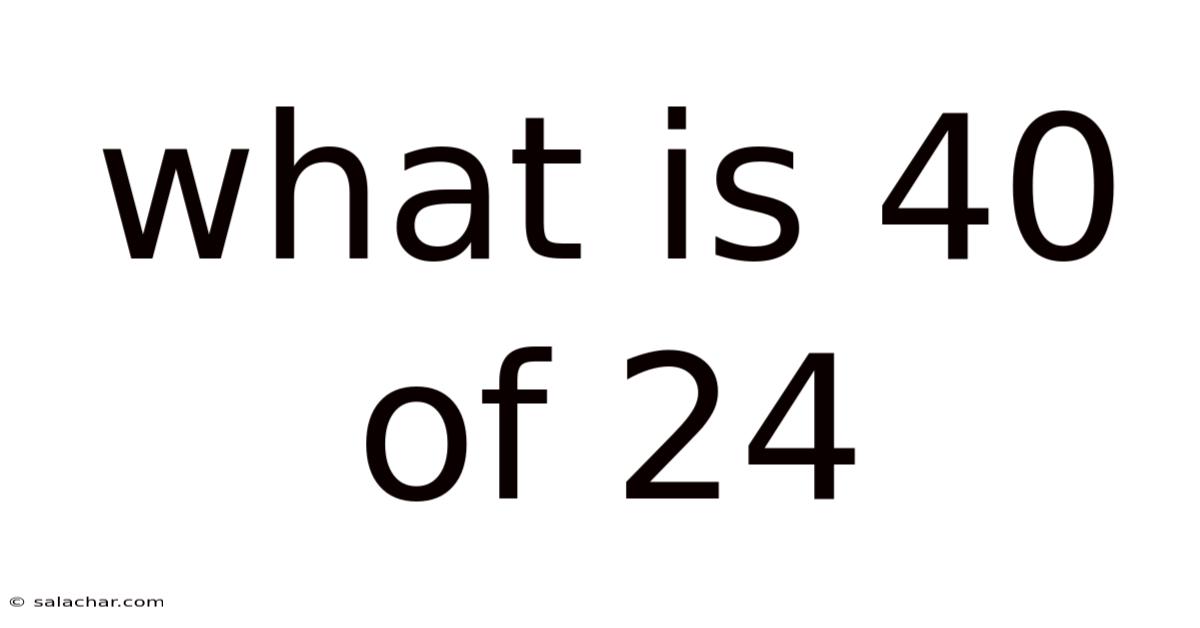What Is 40 Of 24
salachar
Sep 10, 2025 · 4 min read

Table of Contents
What is 40% of 24? A Deep Dive into Percentages and Their Applications
Finding 40% of 24 might seem like a simple arithmetic problem, but understanding the underlying concepts opens doors to a world of applications in various fields. This article will not only solve this specific problem but also provide a comprehensive understanding of percentages, different methods of calculation, and real-world examples where this type of calculation is crucial. We'll delve into the mathematical principles, explore various approaches, and even tackle some common misconceptions. By the end, you'll be confident in calculating percentages and applying this knowledge to various scenarios.
Understanding Percentages: The Foundation
A percentage is a fraction or a ratio where the denominator is always 100. It represents a portion of a whole. The symbol "%" represents "per cent," meaning "out of one hundred." So, 40% means 40 out of 100, which can be written as the fraction 40/100 or the decimal 0.40. Understanding this fundamental concept is key to mastering percentage calculations.
Method 1: Using the Fraction Method to Calculate 40% of 24
This is a straightforward method, perfect for those who prefer working with fractions. We can express 40% as the fraction 40/100. To find 40% of 24, we multiply 24 by 40/100:
(40/100) * 24 = (2/5) * 24 = 48/5 = 9.6
Therefore, 40% of 24 is 9.6.
Method 2: Using Decimal Conversion to Calculate 40% of 24
This method involves converting the percentage to its decimal equivalent. As mentioned earlier, 40% is equal to 0.40. We simply multiply 24 by 0.40:
0.40 * 24 = 9.6
Again, we arrive at the answer: 40% of 24 is 9.6.
Method 3: Using Proportions to Calculate 40% of 24
Proportions offer another elegant way to solve this problem. We set up a proportion where 'x' represents the unknown value (40% of 24):
40/100 = x/24
To solve for 'x', we cross-multiply:
40 * 24 = 100 * x
960 = 100x
x = 960/100 = 9.6
This confirms that 40% of 24 is 9.6.
Real-World Applications of Percentage Calculations
The ability to calculate percentages is incredibly useful in various real-world situations. Here are some examples:
-
Sales and Discounts: Stores frequently offer discounts as percentages. If a shirt costs $24 and is on sale for 40% off, you would save $9.60 (40% of $24).
-
Taxes and Tips: Calculating sales tax or gratuity (tips) often involves percentages. If the sales tax is 6% on a $24 item, you would calculate 6% of $24 to find the amount of tax.
-
Financial Calculations: Interest rates, loan payments, and investment returns are often expressed as percentages. Understanding percentage calculations is vital for managing personal finances effectively.
-
Statistical Analysis: Percentages are fundamental in statistical analysis, used to represent proportions, frequencies, and probabilities. For example, in a survey, percentages are used to represent the proportion of respondents who chose a particular answer.
-
Scientific Applications: Percentages are employed across various scientific disciplines. For example, in chemistry, concentration is often expressed as a percentage.
-
Data Representation: Percentages are a powerful tool for visualizing and understanding data. They simplify complex figures and make comparisons easier to grasp.
Expanding the Understanding: Beyond 40% of 24
While we've focused on finding 40% of 24, the methods discussed can be applied to any percentage and any number. The key is to understand the underlying concepts of fractions, decimals, and proportions.
Common Mistakes to Avoid
-
Incorrect Decimal Conversion: A common mistake is incorrectly converting percentages to decimals. Remember to divide the percentage by 100. For example, 40% is 40/100 = 0.40, not 0.4.
-
Misunderstanding the 'of' Operation: The word "of" in percentage calculations always indicates multiplication.
-
Order of Operations: When dealing with more complex calculations involving percentages, follow the order of operations (PEMDAS/BODMAS) carefully to avoid errors.
Frequently Asked Questions (FAQ)
Q: What is the easiest way to calculate percentages?
A: The easiest method depends on individual preference. Many find the decimal conversion method the most straightforward. However, the fraction method offers a good understanding of the underlying mathematical principles.
Q: Can I use a calculator to calculate percentages?
A: Yes, most calculators have a percentage function (%) that simplifies the calculation.
Q: What if I need to calculate a percentage increase or decrease?
A: Percentage increase or decrease calculations involve finding the difference between two values and expressing it as a percentage of the original value.
Conclusion: Mastering Percentages – A Valuable Skill
Calculating 40% of 24, as we've seen, isn't just about arriving at the answer (9.6). It's about understanding the fundamental principles of percentages and their wide-ranging applications. Mastering percentage calculations is a valuable skill that extends far beyond simple arithmetic problems. It empowers you to confidently tackle various real-world scenarios, from managing your finances to interpreting data and making informed decisions. By understanding the different methods, avoiding common pitfalls, and practicing regularly, you'll become proficient in this essential mathematical skill. Remember, the more you practice, the easier and more intuitive these calculations will become.
Latest Posts
Latest Posts
-
1 Metric Ton In Kg
Sep 10, 2025
-
What Are Properties Of Solutions
Sep 10, 2025
-
Cross Section Area Of Cylinder
Sep 10, 2025
-
250 Million Dollars To Rupees
Sep 10, 2025
-
Definition For Coefficient In Science
Sep 10, 2025
Related Post
Thank you for visiting our website which covers about What Is 40 Of 24 . We hope the information provided has been useful to you. Feel free to contact us if you have any questions or need further assistance. See you next time and don't miss to bookmark.